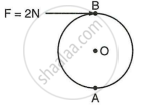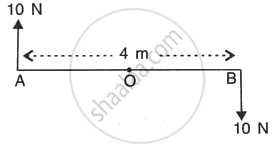Advertisements
Advertisements
प्रश्न
How does the effect of force differ when it is applied on a non-rigid body?
उत्तर
When a force is applied on a non-rigid object it changes interspacing between its constituent particle and causes a change in its dimensions and can produce motion in it.
APPEARS IN
संबंधित प्रश्न
To obtain a given moment of force for turning a body, the force needed can be decreased by
State the S.I. unit of moment of force.
What are contact forces? Give two Example
A wheel of diameter 2 m is shown in the figure with the axle at O. A force F = 2 N is applied at B in the direction shown in the figure. Calculate the moment of force about
- the centre O, and
- the point A.

Two forces each of magnitude 10 N act vertically upwards and downwards respectively at the two ends A and B of a uniform rod of length 4 m which is pivoted at its midpoint O as shown in the figure. Determine the magnitude of the resultant moment of forces about the pivot O.

What is the work done when no net force is applied on the body?
The diagram shows a uniform metre rule weighing 100gf, pivoted at its centre O. Two weights 150gf and 250gf hang from the point A and B respectively of the metre rule such that OA = 40 cm and OB = 20 cm. Calculate :
the total clockwise moment about O

What is meant by the term ‘moment of force’? If the moment of force is assigned a negative sign then will the turning tendency of the force be clockwise or anti-clockwise?
A uniform metre scale is balanced at a 40 cm mark when weights of 20 gf and 5 gf are suspended at 5 cm mark and 75 cm mark respectively. Calculate the weight of metre scale.
A couple of 15 N force acts on a rigid body, such that arm of couple is 85 cm. Calculate moment of couple in the SI system.
